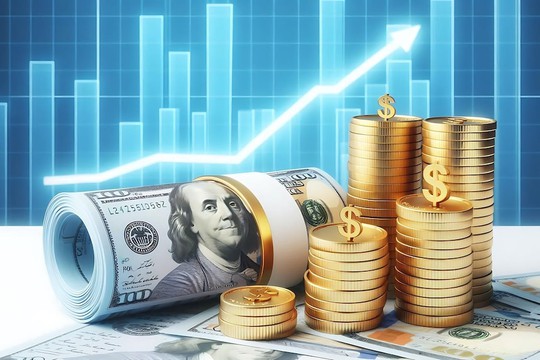Pic.: AI
One of the main reasons why the price of gold has been on a tear is that gold is reentering the global monetary system, writes Ronnie Stoeferle, the financial analyst from the famous Gold Center ‘Von Greyerz AG’ in Switzerland.
After a brief setback below USD 3,000, the USD 3,200 mark was broken on April 11, the USD 3,300 mark on April 16, marking new all-time highs. However, the significant depreciation of the US dollar – the US dollar index fell by around 4% within a few days, by more than 4% against the euro and by around 8% against the Swiss franc – meant that the gold price in euro rose only slightly and fell by more than 4% in Swiss francs. By way of comparison, the S&P 500 dropped by more than 7%.
One reason for gold’s strength is its portfolio property as a hedge against (economic) political uncertainties of any kind, whether due to armed conflicts, political crises or trade conflicts. The positive correlation between the gold price in US dollars and the World Uncertainty Index is evident.
Another reason is the express wish of Donald Trump and his administration to significantly weaken the US dollar. The prevailing view in the US administration is that a strong US dollar is detrimental to the US economy. However, the former Deutschmark bloc around Germany and Switzerland, the latter still today, show that this argument does not stand up to reality. Regardless of this, the US dollar should be significantly devalued and, in conjunction with the tariffs, force the reindustrialization of the US – in line with the America First policy.
In the course of discussions about the domestic and foreign policy, economic and trade policy reorganization desired by Trump and his administration, the idea has been floated that the US could raise its considerable gold reserves. Currently, the gold reserves held by the US Treasury are shown on the Federal Reserve’s balance sheet as a gold certificate at a value of just USD 42.22 per ounce. This was the value of an ounce of gold in 1973 after the last official devaluation of the US dollar against gold. With a revaluation to the current gold price of around USD 3,000, the US could raise around USD 800 billion in a one-off transaction.
The role of gold as a reputable and valuable asset is becoming increasingly important. Gold is gradually moving away from its previous underdog role, especially because long-serving safe anchors such as government bonds, in particular, US Treasuries and German Bunds, in particular, are coming under increasing pressure, largely through their own fault…
Another possible use for the US gold treasure comes from Judy Shelton. Many years ago, Judy Shelton, who is seen as a possible successor to Jerome Powell, whose term ends in 2026, presented her plan for a gold-backed government bond. The plan is simple and includes two main components: gold convertibility and the revaluation of the US’s current gold reserves mentioned above. Selected US Treasury emissions with a 50-year term, for example, would include an option for the bondholder to redeem the bond for a predetermined amount of gold per USD 1,000 face value in gold.
Regardless of whether this plan is implemented or not. It is further proof that gold is seen as a serious asset for solving serious economic problems.
With Donald Trump’s inauguration, uncertainty in international politics, geopolitical dynamics and the financial markets has increased significantly. It remains to be seen how long this phase will last, especially with the new factor of the US’s erratic tariff policy. What is certain is that gold is benefiting from the increased uncertainty. It is also certain that gold’s role as a neutral asset without counterparty risk has been strengthened. What is new is that gold is also increasingly being rediscovered as an economic policy instrument. Gold should also become even more attractive for investors due to the volatility and weakness of the equity and bond markets.
…As of May 1, the price of gold was $3,228.35 per ounce.
read more in our Telegram-channel https://t.me/The_International_Affairs

 10:45 02.05.2025 •
10:45 02.05.2025 •























